N E W M E D I A A R T . E U
> Paris Photo
> Art, technology and AI
> Immersive Art
> Chroniques Biennial
> 7th Elektra Biennial
> 60th Venice Biennial
> Endless Variations
> Multitude & Singularity
> Another perspective
> The Fusion of Possibilities
> Persistence & Exploration
> Image 3.0
> BioMedia
> 59th Venice Biennale
> Decision Making
> Intelligence in art
> Ars Electronica 2021
> Art & NFT
> Metamorphosis
> An atypical year
> Real Feelings
> Signal - Espace(s) Réciproque(s)
> On Combinations at Work
> Human Learning
> Attitudes and forms by women
> Ars Electronica 2019
> 58th Venice Biennale
> Art, Technology and Trends
> Art in Brussels
> Plurality Of Digital Practices
> The Chroniques biennial
> Ars Electronica 2018
> Montreal BIAN 2018
> Art In The Age Of The Internet
> Art Brussels 2018
> At ZKM in Karlsruhe
> Lyon Biennale 2017
> Ars Electronica 2017
> Digital Media at Fresnoy
> Art Basel 2017
> 57th Venice Biennial
> Art Brussels 2017
> Ars Electronica, bits and atoms
> The BIAN Montreal: Automata
> Japan, art and innovation
> Electronic Superhighway
> Lyon Biennale 2015
> Ars Electronica 2015
> Art Basel 2015
> The WRO Biennale
> The 56th Venice Biennale
> TodaysArt, The Hague, 2014
> Ars Electronica 2014
> Basel - Digital in Art
> The BIAN Montreal: Physical/ity
> Berlin, festivals and galleries
> Unpainted Munich
> Lyon biennial and then
> Ars Electronica, Total Recall
> The 55th Venice Biennale
> The Elektra Festival of Montreal
> Digital practices of contemporary art
> Berlin, arts technologies and events
> Sound Art @ ZKM, MAC & 104
> Ars Electronica 2012
> Panorama, the fourteenth
> International Digital Arts Biennial
> ZKM, Transmediale, Ikeda and Bartholl
> The Gaîté Lyrique - a year already
> TodaysArt, Almost Cinema and STRP
> The Ars Electronica Festival in Linz
> 54th Venice Biennial
> Elektra, Montreal, 2011
> Pixelache, Helsinki, 2011
> Transmediale, Berlin, 2011
> The STRP festival of Eindhoven
> Ars Electronica repairs the world
> Festivals in the Île-de-France
> Trends in Art Today
> Emerging artistic practices
> The Angel of History
> The Lyon Biennial
> Ars Electronica, Human Nature
> The Venice Biennial
> Nemo & Co
> From Karlsruhe to Berlin
> Media Art in London
> Youniverse, the Seville Biennial
> Ars Electronica, a new cultural economy
> Social Networks and Sonic Practices
> Skin, Media and Interfaces
> Sparks, Pixels and Festivals
> Digital Art in Belgium
> Image Territories, The Fresnoy
> Ars Electronica, goodbye privacy
> Digital Art in Montreal
> Art, technology and AI
> Immersive Art
> Chroniques Biennial
> 7th Elektra Biennial
> 60th Venice Biennial
> Endless Variations
> Multitude & Singularity
> Another perspective
> The Fusion of Possibilities
> Persistence & Exploration
> Image 3.0
> BioMedia
> 59th Venice Biennale
> Decision Making
> Intelligence in art
> Ars Electronica 2021
> Art & NFT
> Metamorphosis
> An atypical year
> Real Feelings
> Signal - Espace(s) Réciproque(s)
> On Combinations at Work
> Human Learning
> Attitudes and forms by women
> Ars Electronica 2019
> 58th Venice Biennale
> Art, Technology and Trends
> Art in Brussels
> Plurality Of Digital Practices
> The Chroniques biennial
> Ars Electronica 2018
> Montreal BIAN 2018
> Art In The Age Of The Internet
> Art Brussels 2018
> At ZKM in Karlsruhe
> Lyon Biennale 2017
> Ars Electronica 2017
> Digital Media at Fresnoy
> Art Basel 2017
> 57th Venice Biennial
> Art Brussels 2017
> Ars Electronica, bits and atoms
> The BIAN Montreal: Automata
> Japan, art and innovation
> Electronic Superhighway
> Lyon Biennale 2015
> Ars Electronica 2015
> Art Basel 2015
> The WRO Biennale
> The 56th Venice Biennale
> TodaysArt, The Hague, 2014
> Ars Electronica 2014
> Basel - Digital in Art
> The BIAN Montreal: Physical/ity
> Berlin, festivals and galleries
> Unpainted Munich
> Lyon biennial and then
> Ars Electronica, Total Recall
> The 55th Venice Biennale
> The Elektra Festival of Montreal
> Digital practices of contemporary art
> Berlin, arts technologies and events
> Sound Art @ ZKM, MAC & 104
> Ars Electronica 2012
> Panorama, the fourteenth
> International Digital Arts Biennial
> ZKM, Transmediale, Ikeda and Bartholl
> The Gaîté Lyrique - a year already
> TodaysArt, Almost Cinema and STRP
> The Ars Electronica Festival in Linz
> 54th Venice Biennial
> Elektra, Montreal, 2011
> Pixelache, Helsinki, 2011
> Transmediale, Berlin, 2011
> The STRP festival of Eindhoven
> Ars Electronica repairs the world
> Festivals in the Île-de-France
> Trends in Art Today
> Emerging artistic practices
> The Angel of History
> The Lyon Biennial
> Ars Electronica, Human Nature
> The Venice Biennial
> Nemo & Co
> From Karlsruhe to Berlin
> Media Art in London
> Youniverse, the Seville Biennial
> Ars Electronica, a new cultural economy
> Social Networks and Sonic Practices
> Skin, Media and Interfaces
> Sparks, Pixels and Festivals
> Digital Art in Belgium
> Image Territories, The Fresnoy
> Ars Electronica, goodbye privacy
> Digital Art in Montreal
> >
ARS ELECTRONICA, GOODBYE PRIVACY
by Dominique Moulon [ November 2007 ]
The Ars Electronica Festival reveals the principal trends of each year and in 2007, finally found its place within “Second Life”. But this twenty-eight edition, through its symposium entitled “Goodbye Privacy”, was also the occasion for a more general reflection on the notion of privacy within the digital age. As for the appearance of a prize celebrating “hybrid” works of art, it spotlit the emergence of an aesthetic field that questions the living.
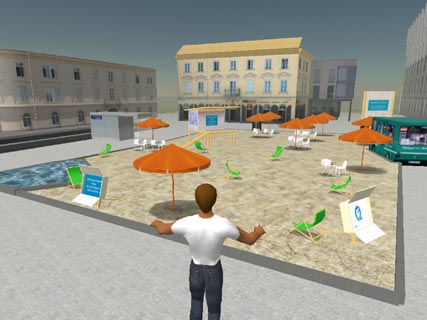
The Pfarrplatz,
in Second Life.

Eva & Franco Mattes,
“Synthetic Performance”,
2007.
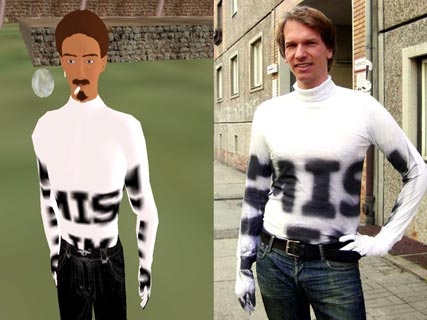
Aram Bartholl,
“Missing Image”,
2007.

Manu Luksch,
“Faceless”,
2002-2007.
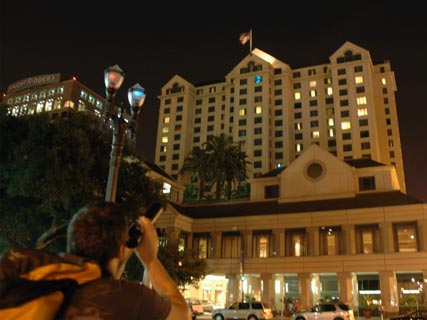
Ashok Sukumaran,
“Park View Hotel”,
2006.

Julien Maire,
“Digit”,
2006-2007.
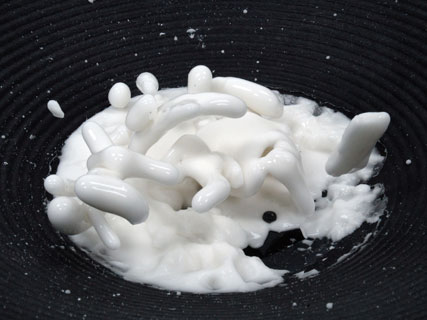
Yoshimasa Kato
& Yuichi Ito,
“White Lives on Speaker”,
2007

The Tissue Culture
& Art Project,
“Victimless Leather”,
2004.
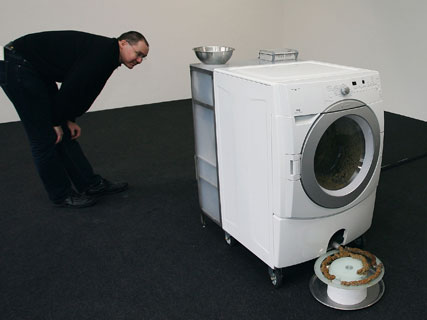
Wim Delvoye,
“Personal Cloaca”,
2007.
Written by Dominique Moulon for "Images Magazine" and translated by Geoffrey Finch for "newmediaart.eu", this article is also available in French on "nouveauxmedias.net".